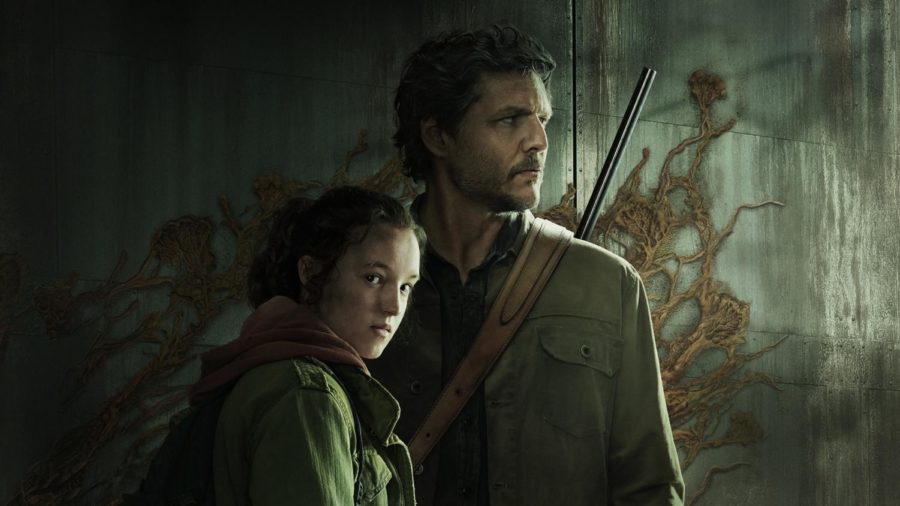“The Last of Us” turns the PlayStation exclusive into a record-breaking TV hit
Courtesy of Warner Bros. Television Studios
In this adaptation of the horror video game “The Last of Us,” Bella Ramsey’s Ellie (left) and Pedro Pascal’s Joel (right) rely on each over to survive an apocalypse.
January 27, 2023
Spoiler alert for the first episode of “The Last of Us”
The zombie apocalypse trope has, frankly, been overdone within media. From survival video games to television shows and movies, it’s hard to find something refreshing that “revives” the genre enough to really invigorate fans. In 2013, Sony and Naughty Dog’s survival horror video game “The Last of Us” managed to do just that, leaving a lasting impression on fans and the video game industry as a whole. The sequel, “The Last of Us Part II,” was also widely praised by critics for its groundbreaking work, continuing the beloved storyline by spotlighting human characters in an apocalyptic setting. After years of waiting, HBO Max has finally released the first two episodes of the show “The Last of Us,” which closely follows the storyline of the original beloved game. The release has smashed records for the streaming service with new and old fans swarming the site.
Both the show and the game break away from the zombie apocalypse tradition, specifically by excluding traditional zombies altogether. In both versions of “The Last of Us,” people become infected rather than dying and are reanimated when a fungus takes control of their brains and bodies. Their only purpose once infected is to spread the fungi as much as possible. Entire areas can become infested with tendrils and—only in the game—airborne spores, which work to spread the virus to the healthy survivors. In the show, rather than spreading through spores, the show’s infected are part of a hive mind, with touching a tendril able to awaken infected over a mile away. The characters are driven away from safety by the hordes of zombies, while in the game it is the military that is forcing them to run. There has been some controversy about the change, but I appreciate any excuse to see more of the incredible special effects on the infected. And what’s the point of an apocalypse if they’re just running from guys with guns?
With that disclaimer out of the way, let’s get into the nitty-gritty of the long-awaited premiere. The show opens with a talk show taking place in 1968, where a scientist warns about the potential dangers of fungi. Compared to bacteria and viruses, fungi have no cure or vaccine to help combat them, leaving the human race vulnerable to an outbreak. The talk show ends on a serious note, with the scientist suggesting that if such a thing happens, “we lose.” While this scene does not occur in the game, it provides new fans with just the right amount of information to drop them straight into the apocalyptic world. They are quite literally thrust into the reality that fungi could and will evolve in the show, and the transition between that information and the actual story is almost seamless.
Following the credits, we are introduced to Joel Miller (Pedro Pascal) and his daughter Sarah (Nico Parker) in Texas in 2003. The show opens on Joel’s birthday, but unfortunately, he has to work. After school, Sarah sneaks downtown to get her dad a birthday present but she sees a ton of emergency response vehicles and is rushed out of the store by the owner. She returns briefly to an empty house before the neighbor’s dog brings her face-to-face with an infected. Joel and his brother Tommy show up to rescue her but cannot get around the military blockade in the street. They flee downtown as the infected begin to ravage the population. A soldier comes across Joel, carrying an injured Sarah, and apologizes before firing at the two, killing Sarah in the process before Tommy saves Joel.
The show then jumps 20 years into the future to a quarantine zone, QZ, established by FEDRA (the Federal Disaster Response Agency), which in essence is a military dictatorship in Boston. Joel continues to search for his brother while picking up odd jobs around the QZ. He and his friend, Tess (Anna Torv), have become smugglers and often sell their goods to the guards. They stumble across the remnants of a shootout involving the Fireflies, a revolutionary group working to dismantle military control over the QZ. Marlene (Merle Dandridge), the leader of the Fireflies, asks Joel to take a young girl, Ellie, out of the QZ to a Firefly safehouse. Although viewers aren’t told exactly why, we know that the girl is extremely important to humanity’s survival. It is only later that we find out that Ellie is immune to the fungus, as she had previously been bitten and not turned. The trio manages to escape the QZ, but not before killing a guard who threatened to hang them for leaving. The premiere ends as Joel, Ellie and Tess manage to escape the QZ towards downtown Boston, with a thunderstorm providing them cover.
Although the show has only released two episodes so far, the premiere has been more than promising. Since I played the video game, I was excited to see the show’s release. The premiere genuinely had me on the edge of my seat the entire time, even though I already knew everything that was going to happen. The show has managed to reinvigorate a story that I previously knew, and dragged me into that world again, just as the game had. The story in “The Last of Us” continues on HBO Max every Sunday at 6 p.m. If you’re a returning fan or just looking for something new, I guarantee this show will have you engaged and praying that fungi can’t mutate.



